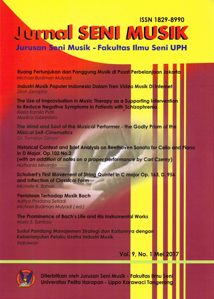Penerapan Latihan Mental untuk Meningkatkan Memorisasi dalam Pembelajaran Piano Klasik pada Mahasiswa Program Studi Musik Universitas Pelita Harapan
Trefwoorden:
memorisasi, latihan mental, imagerySamenvatting
Memorisasi khususnya dalam pembelajaran karya piano klasik adalah hal yang menuntut pelajar untuk menguasai berbagai macam aspek. Karena kerumitan tersebut, tidak asing untuk melihat atau mengalami memory slip pada saat mempertunjukkan permainan tanpa partitur. Selebihnya, ada sebagian orang yang membutuhkan waktu yang sangat lama untuk bisa menghafal sebuah lagu. Penelitian ini bertujuan untuk menganalisis dampak penerapan latihan mental pada pembelajaran karya piano klasik agar kendala dan hambatan seperti itu dapat dihindari untuk kedepannya. Metode penelitian ini menggunakan Non-Equivalent Control Group Design yang berupa perbandingan antara Kelompok Variabel (menerapkan gabungan latihan mental dan fisik) dan Kelompok Kontrol (menerapkan latihan fisik saja) yang mempelajari Intermezzo Op. 117 No. 2 oleh Brahms. Tindakan ini dilakukan dalam jangka waktu 7 hari berturut-turut, 45 menit per sesi. Hasil dari penelitian ini menemukan bahwa tingkat memorisasi Kelompok Variabel yang menjalani latihan mental lebih tinggi dari Kelompok Kontrol dengan selisih 5.37%. Ditemukan juga bahwa latihan mental memiliki peran yang penting bagi partisipan untuk bermain dengan musikalitas yang lebih baik.
Referenties
Chua, W. L. (2014). A Closer Look at Strategies for Memorization, 50-52.
Connolly, C., & Williamon, A. (2004). Musical excellence: Strategies and techniques to enhance performance, Oxford, UK: Oxford University Press, 221-245.
Cutler, J. (2011). Sound Before Symbol. The DaCapo Music Foundation
Fine, P. A., Wise, K. J., Goldemberg, R., Bravo, A. (2015). Performing Musicians’ Understanding of the Terms “Mental Practice” and “Score Analysis”. American Psychological Association. http://dx.doi.org/10.1037/pmu0000068
Garaulet, O. A. (2019). Piano and Memory: Strategies to Memorize Piano Music. https://www.diva-portal.org/smash/get/diva2:1381619/FULLTEXT03.pdf
Paterno, G. (2019). The five contributing elements in Music Analysis. WKMT.
Lieberman, D. A. (2012). Human Learning and Memory. Cambridge University Press. https://ezproxy.library.uph.edu:2541/ehost/detail/detail?vid=0&sid=fe8dad20- 8bba-4b25-9112-2029efba64b8%40redis&bdata=JnNpdGU9ZWhvc3QtbGl2ZQ%3d%3d#AN= 415667&db=e000xww
May, H. (2012). Nonequivalent comparison group designs. In H. Cooper, P. M. Camic, D. L. Long, A. T. Panter, D. Rindskopf, & K. J. Sher (Eds.), APA handbook of research methods in psychology, Vol. 2. Research designs: Quantitative, qualitative, neuropsychological, and biological (pp. 489-509). American Psychological Association. https://doi.org/10.1037/13620-026
O. Immonen, I. Ruokonen, & H. Ruismaki. (2012). Elements of mental training in music. Procedia-Social and Behavioral Sciences, 45, 588-594. doi:10.1016/j.sbspro.2012.06.596
Saintilan, N. (2014). The uses of imagery during the performance of memorized music. Psychomusicology: Music, Mind, and Brain, 24, 309-315. 10.1037/pmu0000080
Sugiyono. (2015). Metode Penelitian Tindakan Komprehensif. Bandung: Alfabeta
Theiler, A. M., & Lippman, L. G. (1995). Effects of mental practice and modeling on guitar and vocal performance. The Journal of General Psychology, 329- 343. https://doi.org/10.1080/00221309.1995.9921245
Zixiang, S. S., Mohammed S. F. S., Fischer, N. (2022). Self-Directed Memorizing Methods Engaged by Pianists. International Journal of Innovation, Creativity, and Change. 16(1), 908.
##submission.downloads##
Gepubliceerd
Nummer
Sectie
Licentie
Copyright (c) 2024 Josephine Nicole Wirawan, Jane Djie

Dit werk wordt verdeeld onder een Naamsvermelding-GelijkDelen 4.0 Internationaal licentie.
Authors who publish with this journal agree to the following terms:
1) Authors retain copyright and grant the journal the right of first publication with the work simultaneously licensed under a Creative Commons Attribution License (CC-BY-SA 4.0) that allows others to share the work with an acknowledgment of the work's authorship and initial publication in this journal.
2) Authors are able to enter into separate, additional contractual arrangements for the non-exclusive distribution of the journal's published version of the work (e.g., post it to an institutional repository or publish it in a book), with an acknowledgment of its initial publication in this journal.
3) Authors are permitted and encouraged to post their work online (e.g., in institutional repositories or on their website). The final published PDF should be used and bibliographic details that credit the publication in this journal should be included.

